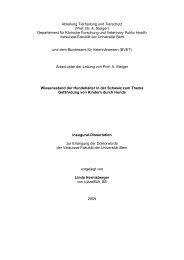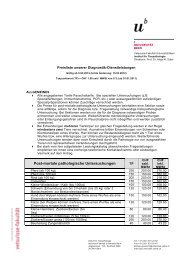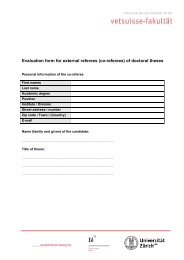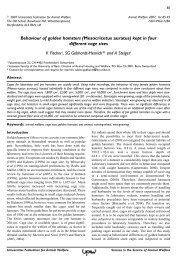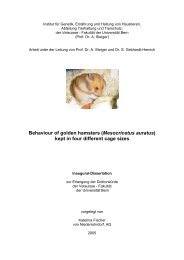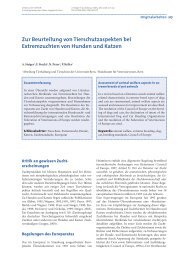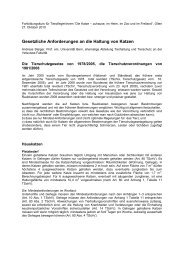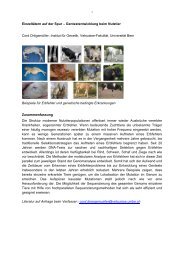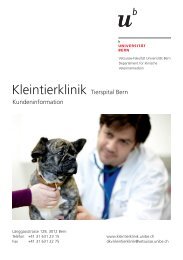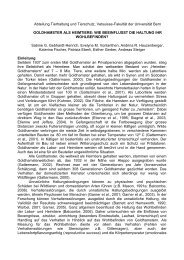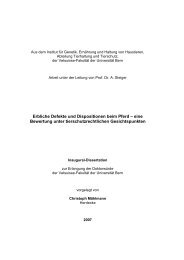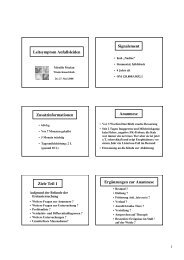Lifespan and Causes of Death in the Irish Wolfhound - Vetsuisse ...
Lifespan and Causes of Death in the Irish Wolfhound - Vetsuisse ...
Lifespan and Causes of Death in the Irish Wolfhound - Vetsuisse ...
You also want an ePaper? Increase the reach of your titles
YUMPU automatically turns print PDFs into web optimized ePapers that Google loves.
3.4.2 Epizootology<br />
In past studies <strong>of</strong> causes <strong>of</strong> death <strong>in</strong> <strong>Wolfhound</strong>s, OS was found to be responsible for<br />
between 21% (Bernardi 1986) <strong>and</strong> 24% (Prokopenko 1998) <strong>of</strong> deaths. In Bernardi’s<br />
data, sex distribution <strong>of</strong> OS was almost equal, with 49.2% males <strong>and</strong> 50.8% females,<br />
while mean age at death was 6.6 years.<br />
There are two numbers on odds ratios available: One study found <strong>Irish</strong> <strong>Wolfhound</strong>s<br />
to have an OR <strong>of</strong> 27.5 as compared to <strong>the</strong> overall dog population (Dorn 2002),<br />
whereas ano<strong>the</strong>r found an OR <strong>of</strong> 20.7 as compared to German Shepherd dogs (Ru,<br />
Terrac<strong>in</strong>i et al. 1998).<br />
Castration has been described as a risk factor for develop<strong>in</strong>g OS (Priester <strong>and</strong><br />
McKay 1980; Ru, Terrac<strong>in</strong>i et al. 1998; Cooley, Beranek et al. 2002). In this study,<br />
this could be reproduced <strong>in</strong> males only dur<strong>in</strong>g re-evaluation <strong>of</strong> <strong>the</strong><br />
Bernardi/Prokopenko data, <strong>in</strong> which <strong>in</strong>formation on castration status was available<br />
(see chapter 5.1.5.2). In <strong>the</strong> latter two quoted studies, it was hypo<strong>the</strong>sised that <strong>the</strong><br />
underly<strong>in</strong>g mechanism may be associated with a longer bone growth period <strong>in</strong><br />
castrated animals, whose growth plates close at a later age than those <strong>of</strong> <strong>in</strong>tact<br />
animals.<br />
3.4.3 Heredity <strong>and</strong> Control Measures<br />
Despite <strong>the</strong> fact that <strong>the</strong> <strong>in</strong>cidence <strong>of</strong> OS varies strongly between different dog<br />
breeds, <strong>and</strong> although familial predispositions have been reported <strong>in</strong> <strong>the</strong> species<br />
(Bech-Nielsen, Hask<strong>in</strong>s et al. 1978), relatively little is known about its underly<strong>in</strong>g<br />
hereditary mechanisms. Involvement <strong>of</strong> mutations <strong>of</strong> <strong>the</strong> p53 tumour suppressor<br />
gene has been described, as have changes <strong>in</strong> several proto-oncogenes (van<br />
Leeuwen, Cornelisse et al. 1997; Johnson, Couto et al. 1998; Mendoza, Konishi et al.<br />
1998; Ferrac<strong>in</strong>i, Angel<strong>in</strong>i et al. 2000; Meyer, Murua Escobar et al. 2004).<br />
Fur<strong>the</strong>rmore, a strong familial OS predisposition has recently been discovered <strong>in</strong> <strong>the</strong><br />
Scottish Deerhound (Hauck, personal communication).<br />
Hereditary cancers are unlikely to be mediated by defective proto-oncogenes, s<strong>in</strong>ce<br />
<strong>the</strong>ir expression would <strong>in</strong>terfere with <strong>the</strong> development <strong>of</strong> <strong>the</strong> embryo. On <strong>the</strong> o<strong>the</strong>r<br />
h<strong>and</strong>, a hereditary cancer caused by a germ l<strong>in</strong>e mutation <strong>of</strong> a tumour suppressor<br />
gene can be expected to follow a dom<strong>in</strong>ant pattern <strong>of</strong> <strong>in</strong>heritance, comb<strong>in</strong>ed with<br />
<strong>in</strong>complete penetrance (environmental <strong>in</strong>teraction <strong>and</strong> o<strong>the</strong>r modulat<strong>in</strong>g factors) <strong>and</strong><br />
embryonic death (lethal factor) <strong>in</strong> homozygotous <strong>in</strong>dividuals. However, <strong>the</strong>re are<br />
o<strong>the</strong>r possible mechanisms <strong>of</strong> hereditary cancer transmission as well, which can be<br />
transmitted through mutations <strong>in</strong> different modulator genes (Ruttemann 2005).<br />
Initial research on Osteosarcoma <strong>in</strong> Scottish Deerhounds (a breed closely related to<br />
<strong>the</strong> <strong>Irish</strong> <strong>Wolfhound</strong>) at <strong>the</strong> universities <strong>of</strong> North Carol<strong>in</strong>a <strong>and</strong> Tennessee <strong>in</strong>dicated a<br />
simple autosomal recessive mode <strong>of</strong> <strong>in</strong>heritance, but this has been shown to be too<br />
simple an approach <strong>in</strong> <strong>the</strong> meantime (Hauck, personal communication).<br />
Given <strong>the</strong> currently available literature, it is realistic to assume a hereditary<br />
component <strong>of</strong> <strong>the</strong> disease, <strong>the</strong> exact nature <strong>of</strong> which rema<strong>in</strong>s unknown for <strong>the</strong> time<br />
be<strong>in</strong>g. It <strong>the</strong>refore seems reasonable not to breed <strong>in</strong>dividuals diagnosed with <strong>the</strong><br />
27



